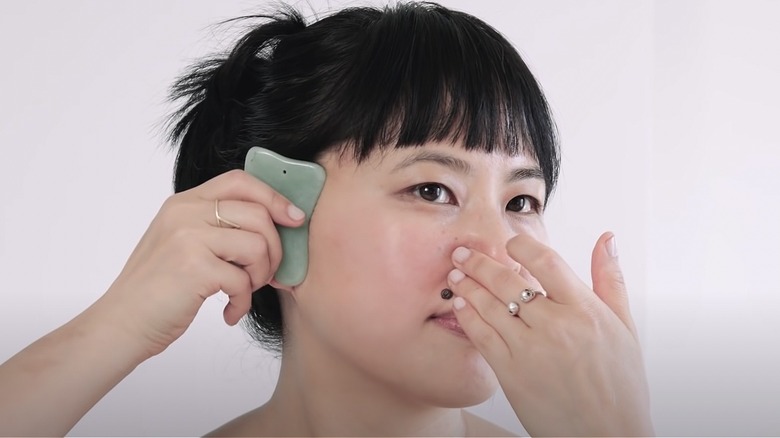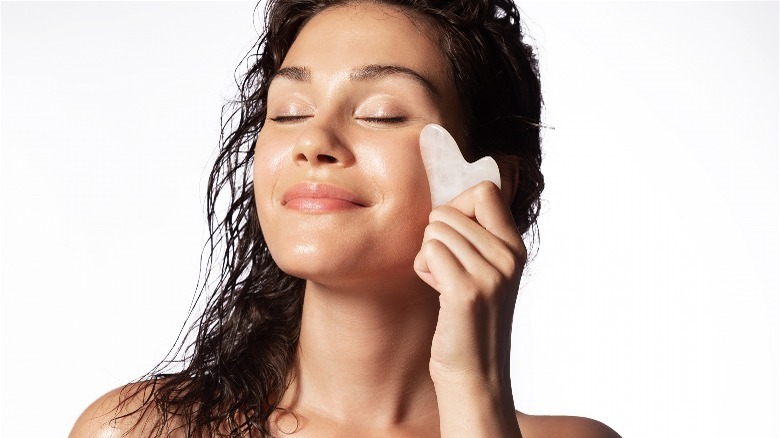The Benefits Of Gua Sha, And How To Use It Authentically
When a cultural wellness practice is appropriated for commercial use, consumers can often get it wrong. Even with the best intentions, a lack of context about cultural attitudes or traditions that inform a specific practice can lead to a less-than-effective and inauthentic experience.
Gua sha, pronounced "gwah-shah," is one such cultural wellness practice that has expanded in popularity on TikTok lately — but is the gua sha we see online the real thing? Or is it the Western consumer's idea of it?
The answer is perhaps a bit of both. Beauty-lovers have been adding facial gua sha to their skincare routines, as the practice has been known to provide numerous benefits. This includes reduced inflammation and puffiness in the face by helping to drain lymph, along with stimulating collagen, which can then assist in alleviating dark circles and soft wrinkles; thus creating the appearance of an overall slimmer face. But it would be a mistake to think that there is nothing more to gua sha than dragging a stone across your face. After being practiced for centuries, using gua sha has been honed to precision, and traditional Chinese medicine (TCM) practitioners lead the charge when it comes to implementing such techniques properly for the most effective results.
From ancient history to modern technology
Originating sometime during the Paleoethic period, Gua sha is not just an ancient practice, but perhaps one of the oldest ancient practices to exist.
According to Harpers Bazaar, the earliest forms of the process involved applying a flattened bian stone to the body to treat medical issues, years before acupuncture. These days, that same stone is still considered the most authentic tool to use for gua sha. Dr. Jennelle Kim told Good Morning America that "Gua sha" roughly translates to "scraping sand," which both invokes the smoothness of motion involved with the practice of scraping the face and body with a worked stone, and the small, red marks that occur on the skin as a result of slight bleeding underneath it, as small as a grain of sand. It can also be translated to "dredging meridian stagnation," per one research study, referring to stagnant qi.
One of the core tenants surrounding TCM is the belief in qi (pronounced "chee"), an inner energy force in constant circulation within the human body. Per the American Institute of Alternative Medicine, it's believed that qi can stagnate in certain areas when our bodies face stress, placing strain on our physical and emotional health. Using specific scraping techniques, Gua sha is used to release that stuck qi.
Now, researchers have been able to study the effects of gua sha using modern technology to reveal scientifically-bolstered benefits beyond its uses as a traditional healing practice, including pain relief and stimulating the immune system.
How to properly use facial gua sha
When it comes to properly practicing gua sha, take advice from practitioners who are trained in its techniques and have an authentic connection to the practice. One TCM practitioner and licensed acupuncturist who goes by Lanshin on TikTok explains in one video to apply the stone to the skin with a light to a maximum medium pressure. "It should feel yummy, like the soft caresses of a soothing massage," she explained. "And so light under the eye, it's like skimming water without making a ripple."
But before performing facial gua sha, remember to cleanse your face, clean your tool, and apply a moisturizer or facial oil so the tool slides with ease across your face. TikTok user @sammy.mcclymonds demonstrates solid technique in her TikTok video tutorial.
In a different video, a TCM practitioner who goes by the username @yang.face describes the importance of choosing the best quality gua sha tools, or "boards," for an authentic practice. She relays that while many mass-produced gua sha tools can be made of glass, ceramic, acrylic, or plastic, users will miss out on the qi or "essence" of the stone tool if using these alternative materials. Using a stone tool is essential to the authenticity of gua sha.
Tips for best results
When it comes to facial gua sha techniques, many tutorials on social media miss the mark. Contrary to what TikTok videos show, you should not be dragging the edge of the tool against your face, as this could lead to skin damage. Instead, the tool should lay almost flush to your face, at a 15 to 30 degree angle, Gua sha facial specialist Su-Man told Refinery29. Starting at center points on your face, scrape the board in upwards motions across the face toward your temples or other high points for several strokes. Be sure to use one hand to hold the tool, and the other to slowly move your hand. This ensures that you are not pulling the skin too hard, and allows for greater precision in your strokes. Be deliberate and slow as you glide the tool as well, again to avoid irritating your skin.
One key thing to avoid? Storing your gua sha tools in the fridge or soaking them in ice water. According to Lin Chen, founder of wellness brand Pink Moon, "In Chinese medicine, there is always this saying to keep things warm," she says to Refinery29. "You don't want your tool to be too cold, because that could increase inflammation." This is, of course, the opposite of what gua sha is meant to do.

